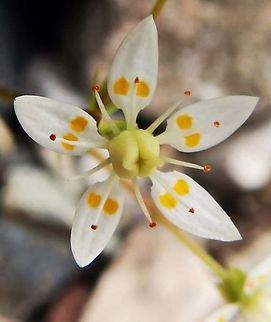
Appearance
''Saxifraga stellaris'' grows as a leaf rosette, which produces a generally leafless stem up to 20 centimetres tall. The leaves are toothed and somewhat fleshy, ovate or obovate, and without an obvious petiole. They are typically 3 cm long , with a cuneate base.The flowers are borne in a loose panicle comprising 5–10 flowers; each flower has deflexed sepals, surrounding five white petals, 3–6 millimetres long, with two yellow or red spots near the base. The anthers are also red or yellow. Flowers are borne from June to August.
The seeds are dark brown, glabrous, 0.6–0.8 mm long, and 0.3–0.4 mm wide. They are elliptic, ovoid or reniform in shape, with longitudinal ribs bearing spines. ''S. stellaris'' has a chromosome number of 2''n'' = 28.
Distribution
''Saxifraga stellaris'' has an Arctic–alpine distribution. It is found from Baffin Island, Labrador and Greenland to Arctic Russia, including Iceland, Scandinavia and the British Isles. Further south, it is found from the Sierra Nevada in southern Spain to the eastern Carpathians, including lower ranges such as the Massif Central....hieroglyph snipped...In the Arctic, ''S. stellaris'' may occur down to sea level. Within the British Isles, ''S. stellaris'' is abundant in North Wales, Northern England and Scotland, reaching the summit of Ben Nevis , but is only found locally in Ireland. Its southernmost stations in Great Britain are the slopes of Plynlimon and the Rheidol valley; it does not occur in the mountains of South Wales. In the Vosges, it occurs around 3,600 ft , but only rarely below 4,300–4,600 ft in the Swiss Alps. In the Sierra Nevada of southern Spain, it lives at up to 3,350 m .
''Saxifraga stellaris'' lives in damp environments, such as wet flushes, beside streams or springs, or on wet rock ledges. It is self-compatible, but its flowers are protandrous, and are usually pollinated by flies.
Habitat
''Saxifraga stellaris'' has an Arctic–alpine distribution. It is found from Baffin Island, Labrador and Greenland to Arctic Russia, including Iceland, Scandinavia and the British Isles. Further south, it is found from the Sierra Nevada in southern Spain to the eastern Carpathians, including lower ranges such as the Massif Central....hieroglyph snipped...In the Arctic, ''S. stellaris'' may occur down to sea level. Within the British Isles, ''S. stellaris'' is abundant in North Wales, Northern England and Scotland, reaching the summit of Ben Nevis , but is only found locally in Ireland. Its southernmost stations in Great Britain are the slopes of Plynlimon and the Rheidol valley; it does not occur in the mountains of South Wales. In the Vosges, it occurs around 3,600 ft , but only rarely below 4,300–4,600 ft in the Swiss Alps. In the Sierra Nevada of southern Spain, it lives at up to 3,350 m .
''Saxifraga stellaris'' lives in damp environments, such as wet flushes, beside streams or springs, or on wet rock ledges. It is self-compatible, but its flowers are protandrous, and are usually pollinated by flies.
References:
Some text fragments are auto parsed from Wikipedia.